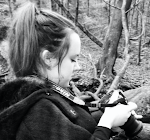On the last day of Creative Exchange Week, we had 7 Alumni come in to present an introduction to their own work and practice and then had the chance for them to do portfolio reviews on our own work. There were a range of different practices and styles of work among them, and each person gave a short presentation into who they are and what they do.
Each presentation was interesting in their own ways, and showed a range of photographic practices which were all equally engaging as a viewer. Some Alumni were more similar to my own interests than others, however it was still useful to see the others as well.
Daniel Ainsworth who runs Pupils Sphere talk was in particular interesting as it shows ways of working with photography other than taking photos. He spoke of curatorial practice and working with exhibitions.
Tom Duffield spoke about his photo book 'The Whole House is Shaking' (which I went to the launch of the night before). He mentioned what the project is about and a little bit into the inspiration behind some of the images. An interesting point about his project, was that it turned into more of a collaboration between family members which is something I can consider in the development of my own project. One thing he said that stuck with me is about making work without knowing where its going to go, in which he ended his presentation with some of his own images. This is something I need to do more of, as I'm often focused on one project that I may miss photo opportunities for others.
Other speakers included Sophie Abbott who produced a fine art based project for her FMP but then went into fashion, Tim Brown who also spoke about his FMP and going from BA to MA in Digital Media, Nicole Jopek who produces fashion work, Laura Patrick from a commercial perspective and Sam Welburn who produces Landscapes but also worked with the Archive in his project 'Coalface'.
I also had a portfolio review with Sam Welburn as looking on his website before he has a project titled 'Son of Fire' which concentrated on his Grandfather and also combined archival material which was similar to my project I am currently starting. A few points I took from the review:
- Keep Shooting. He mentioned I had already a good amount of images but to keep shooting as doing this will give me a wider range of material to work with.
- Speaking about myself being unsure if to take portraits of my grandmother, he said take them anyways. Even if I don't use them, it still works to try it and something may come from them that I hadn't thought of before.
- Evidence everything. Shoots, and everything in between as all this is included in the development of this project.
- Following on from the last point, he also suggested having conversations and recording them to listen back. Through these nothing may come, yet in some, things may occur which can be useful to my project.
- He also commented on the wide range of approaches I had done which doesn't narrow down my project and is something I can work with moving forward.























